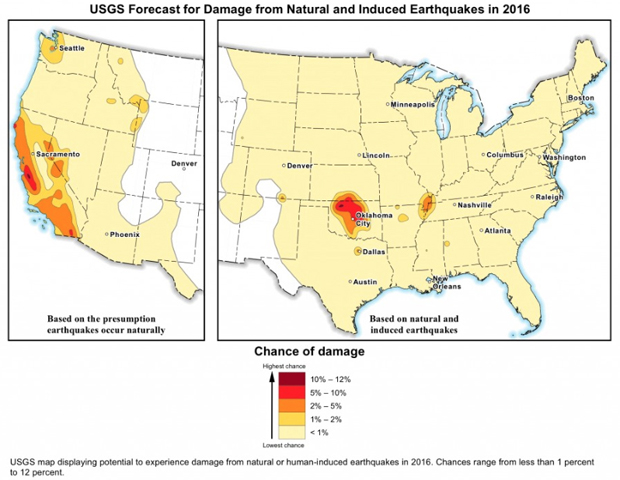USGS: Millions at risk from man-made earthquakes
About 7 million Americans live in areas of the central and eastern United States that could experience a damaging earthquake in 2016 that was caused by human activity such as wastewater disposal from gas production.
For the first time, the U.S. Geological Survey has published an earthquake hazard map pinpointing potential sites of both man-made and naturally occurring earthquakes. The map and an accompanying study were released Monday.
"By including human-induced events, our assessment of earthquake hazards has significantly increased in parts of the U.S.," Mark Petersen, chief of the USGS National Seismic Hazard Mapping Project, said in a press release. "This research also shows that much more of the nation faces a significant chance of having damaging earthquakes over the next year, whether natural or human-induced."
The USGS reported that almost all the risk of increasing man-made quakes is tied to "companies that are injecting wastewater from gas and oil production down to porous rocks far below ground."
"The injection of wastewater into the ground helps to lubricate the fault lines and expand them by over-pressurizing them, and that, we think, is causing this rash of small earthquakes," explained CBS News science contributor Michio Kaku, a physics professor at the City University of New York.
The study reveals that the most significant hazard areas for "induced" or man-make quakes are located in six states -- Oklahoma, Kansas, Texas, Colorado, New Mexico, and Arkansas.
Oklahoma has the highest risk, and along with Texas has the largest population that could be exposed to the risk.
On Tuesday morning, just hours after the report came out, Oklahoma experienced two more quakes with a magnitude of 4.1 and 4.2.
"Ground zero could be Oklahoma, Kansas, Texas, Colorado. Seven million Americans could be affected by this report, which is a game-changer -- human-induced, man-made earthquakes," Kaku told "CBS This Morning." "The number of earthquakes in the area has gone up by a factor of 100, from just a handful per year to more than a thousand just last year."
"In the past five years, the USGS has documented high shaking and damage in areas of these six states, mostly from induced earthquakes," Petersen added. "Furthermore, the USGS Did You Feel It? website has archived tens of thousands of reports from the public who experienced shaking in those states, including about 1,500 reports of strong shaking or damage."
The USGS reports that the central part of the country has experienced the most dramatic increase in seismic activity over the past six years.
Between 1973 and 2008, there was an average of 24 earthquakes with a magnitude of 3.0 or higher each year. The rate increased steadily in the relatively short amount of time between 2009 and 2015, averaging 318 earthquakes per year. This peaked just last year, with 1,010 earthquakes. So far this year, there have been 226 earthquakes of a magnitude of 3.0 or larger in the central U.S. as of mid-March.
The strongest of the quakes measured 5.6, Kaku said. That's powerful enough to cause serious damage if it hit a big metropolitan area like Dallas, where FEMA estimated a 5.6 earthquake could cause $9.5 billion in damage.
To reduce the risk to people and property, Kaku suggested, "We could perhaps do injections away from populated areas. We could do more recycling of the wastewater."

